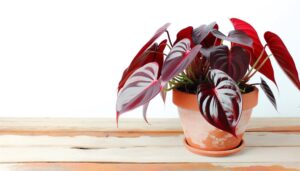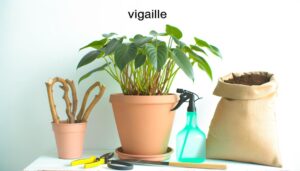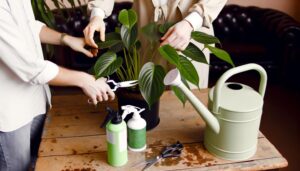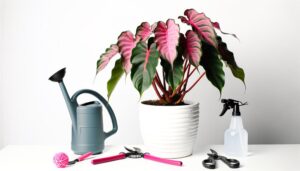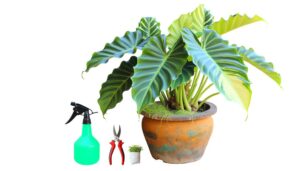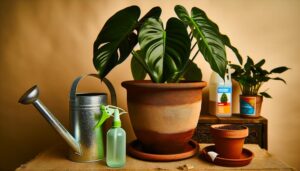Big Leaf Philodendron Care: Tips for Healthy Growth
Big Leaf Philodendron, or Philodendron bipinnatifidum, thrives in moderate temperatures and bright, indirect light. Soil should be peat-rich, well-draining, and within a pH range of 5.0-7.0.
Watering should occur when the top inch of soil is dry; overwatering can cause root rot. High humidity above 40% is recommended.
Use a balanced, water-soluble fertilizer monthly during growth periods, reducing to bi-monthly in winter. Regular pruning of dead leaves should also be conducted.
Prolonged exploration into this plant’s unique care requirements will reveal invaluable insights into propagation, pest control, and more.
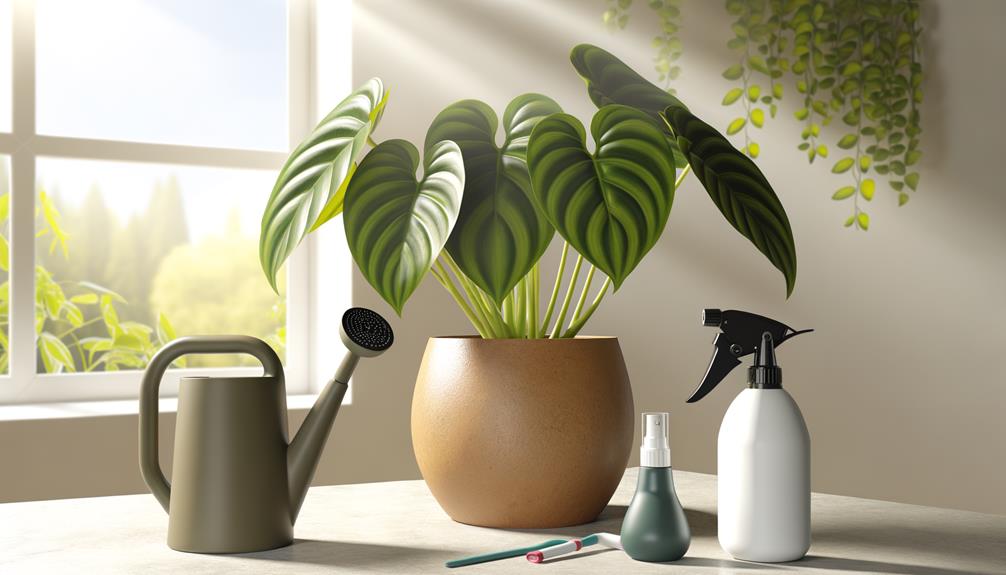
Key Takeaways
- The Big Leaf Philodendron thrives in bright, indirect light, ideally from East or North facing windows.
- This plant prefers high moisture levels, but not waterlogged soil; water when the top inch of soil is dry.
- Maintain a high humidity environment, ideally between 60-80%, using methods like misting or humidity trays.
- Fertilize monthly during the growing season using a balanced water-soluble fertilizer and inspect regularly for pests.
- Prune dead or yellow leaves during the growing season and repot every 2-3 years or when the plant outgrows its pot.
Understanding Big Leaf Philodendron
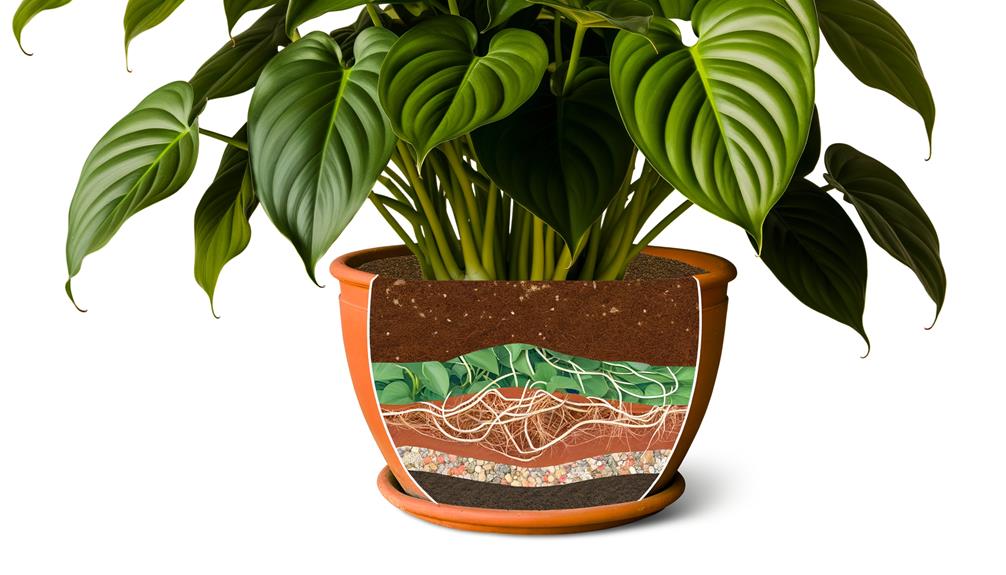
What exactly is a Big Leaf Philodendron, one might wonder?
The Big Leaf Philodendron, or Philodendron bipinnatifidum, is an ornamental, evergreen houseplant native to the rainforests of South America. A member of the Araceae family, this plant is known for its large, glossy, deeply lobed leaves that can reach up to 3 feet in length.
The Big Leaf Philodendron is a self-heading variety, meaning it grows upwards and outwards, forming a bush-like shape. It requires a suitable environment for optimal growth, which includes moderate temperature, humidity, and water conditions.
It is an ideal choice for individuals who wish to cultivate a sense of serenity in their living or working spaces, while also serving as a natural air purifier.
Ideal Light Conditions
Moving onto the topic of lighting, the Big Leaf Philodendron thrives in bright, indirect light conditions, which mimic its natural rainforest habitat. It’s essential to grasp that while this plant appreciates luminosity, it can suffer from too much direct sunlight. Prolonged exposure can lead to leaf burn, characterized by yellow or brown discoloration.
For ideal growth, place your Philodendron in a location with filtered light. East or North facing windows typically offer such conditions. Alternatively, consider artificial lighting solutions, such as fluorescent or LED lights, particularly in low-light environments. However, make sure the light is not too intense and is evenly dispersed.
Understanding and implementing these light conditions is vital in providing the best care for your Philodendron, promoting its health and vibrancy.
Watering Your Philodendron
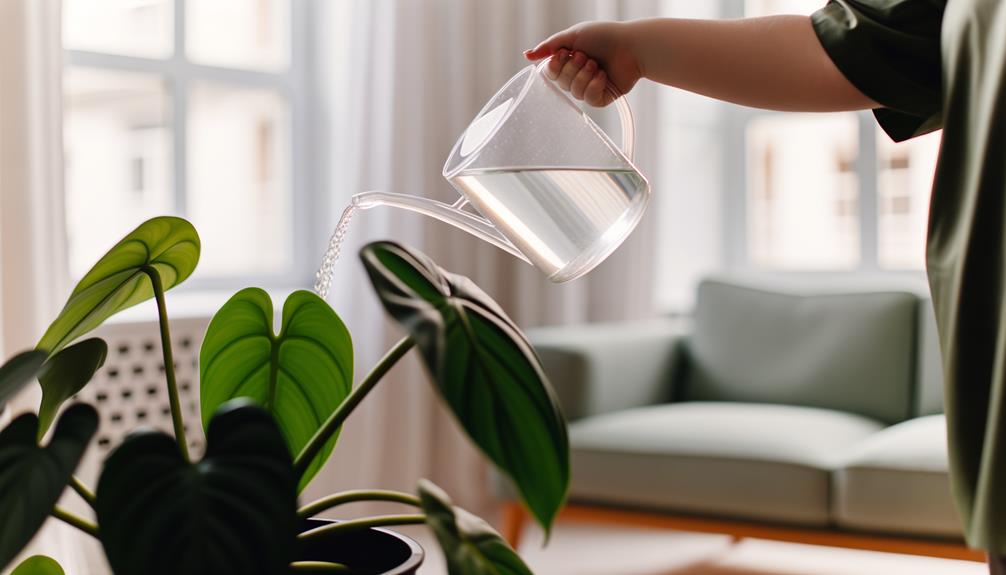
Philodendrons, particularly the big leaf variety, exhibit unique water requirements that must be accurately met to maintain their robustness. Understanding these needs is essential to prevent overwatering, a common issue that can lead to root rot and other harmful conditions.
The following discussion will elucidate the watering specifications of the Philodendron, offering insights into recognising their signs of thirst and strategies for averting overhydration.
Understanding Philodendron’s Thirst
To effectively care for your big leaf philodendron, it is important to understand the plant’s specific hydration needs, as improper watering can lead to various health issues. This tropical species prefers high moisture levels, simulating its natural rainforest habitat. However, it is not a fan of waterlogged soil.
The plant’s hydration requirement fluctuates depending on the environment. Higher humidity and temperature increase the plant’s thirst, while cooler and less humid conditions demand less watering.
The soil type also impacts the watering needs. A well-draining, peat-based potting soil is ideal, as it retains just the right amount of moisture. The golden rule is to wait until the top inch of soil is dry before re-watering. This practice emulates the natural drying cycle philodendrons experience in their native habitats.
Preventing Overwatering Issues
Overwatering, a common pitfall among plant caretakers, can lead to root rot and other detrimental conditions in big leaf philodendrons. Understanding how to prevent it is vital for maintaining your plant’s health.
One must grasp the plant’s specific hydration needs, as philodendrons require well-drained soil and moderate watering. The technique is to water thoroughly but infrequently, allowing the top inch of the soil to dry out between waterings.
Overly damp conditions can promote the growth of harmful fungi and bacteria, so it’s important to maintain a balanced moisture level. Utilizing a moisture meter can be a helpful tool in gauging this.
Essential Humidity Levels
Humidity plays a vital role in the health and growth of big leaf Philodendrons. To guarantee ideal growth, it’s important to understand the plant’s specific humidity needs and maintain an environment that meets these requirements.
However, these plants also exhibit a degree of flexibility and can adapt to lower humidity levels, within certain boundaries.
Understanding Plant Humidity Needs
The necessary humidity levels for the best growth and development of a Big Leaf Philodendron should be carefully considered, as this tropical plant thrives in environments with high moisture content. Understanding the plant’s humidity needs is vital for ensuring its health and strength.
To give you an idea of the ideal humidity range, let’s consider the following table:
| Stage of Growth | Minimum Humidity (%) | Best Humidity (%) |
|---|---|---|
| Seedling | 70 | 80 |
| Juvenile | 60 | 75 |
| Mature | 50 | 70 |
| Blooming | 60 | 80 |
| Post-Blooming | 50 | 70 |
This table simplifies the plant’s varying requirements at different stages of its life cycle, aiding hobbyists and professionals alike in providing the best care for their Big Leaf Philodendron.
Maintaining Ideal Humidity Levels
Now that we’ve established the varying humidity needs of the Big Leaf Philodendron at different stages of its life cycle, let’s focus on the methods for maintaining these ideal conditions effectively.
A hygrometer can be utilized to measure the moisture content in the air accurately. For a humidity level between 60-80%, regularly misting the plant with distilled or rainwater helps.
Placing the Philodendron on a humidity tray or grouping it with other plants can also sustain the required humidity level. However, remember that over-humidity can trigger fungal infections.
For best plant health, balance is critical; neither too low nor excessively high humidity levels are beneficial. Regular monitoring and prompt adjustments ensure the longevity and lush growth of your Big Leaf Philodendron.
Adapting to Low Humidity
While Big Leaf Philodendrons appreciate high moisture levels, they exhibit an impressive ability to adjust to lower humidity conditions, making them suitable for various indoor settings. This adaptability showcases the plant’s durability and its capacity to withstand less-than-ideal conditions.
Nonetheless, to enhance growth and maintain their vibrant appearance, it’s recommended to carefully control their surroundings. During drier periods, it’s advantageous to increase watering frequency, and lightly spray leaves occasionally to replicate a humid atmosphere. Utilizing a humidity tray or placing the plant in a brightly lit bathroom can also be beneficial.
Moisture levels should ideally be maintained above 40% to prevent browning of leaf edges. Nevertheless, Big Leaf Philodendrons can thrive in humidity as low as 30%, making them a flexible addition to your indoor plant collection.
Soil and Fertilizer Needs
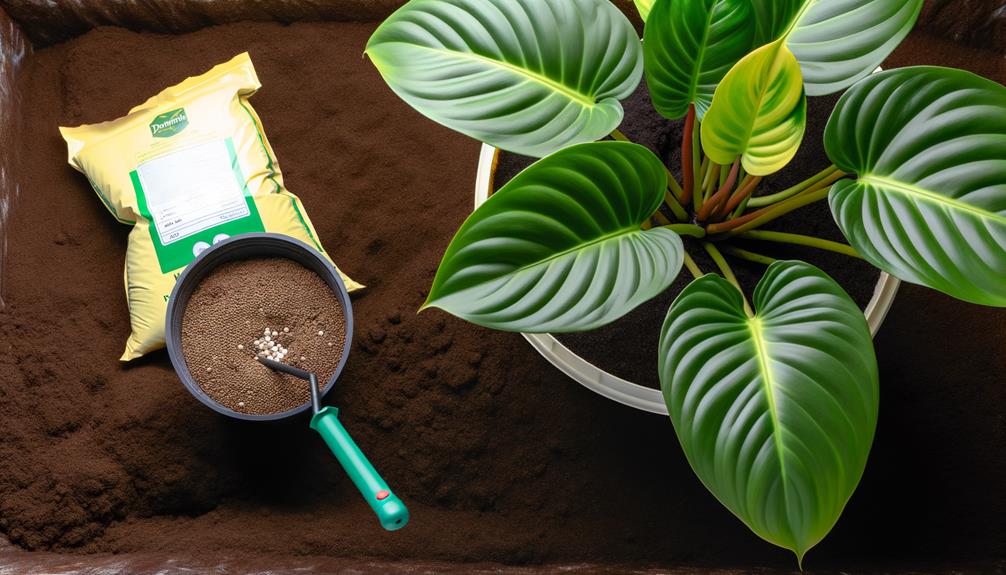
Proper growth and development of the Big Leaf Philodendron highly depend on the quality of soil and the type of fertilizer used. This plant prefers well-draining, peat-based soil, which retains sufficient moisture without causing water-logging. A pH range between 5.0 and 7.0 is ideal, guaranteeing the soil provides a slightly acidic to neutral environment.
Fertilization is equally crucial, and a balanced (20-20-20) water-soluble fertilizer is recommended. This should be applied monthly during the growing season, and reduced to bi-monthly in winter. Over-fertilization can lead to salt build-up, causing leaf burn. Hence, it’s advisable to flush the soil every few months to prevent such accumulation.
Pests and Disease Management
In the field of horticulture, effectively managing pests and diseases is paramount for the health and longevity of the Big Leaf Philodendron. This tropical plant is susceptible to mealybugs, scale insects, aphids and spider mites. These pests feed on the plant’s sap, causing leaf drop and stunted growth.
Caregivers should regularly inspect plants, paying close attention to leaf undersides and stems. If pests are present, apply an insecticidal soap or a horticultural oil, observing all safety measures.
Fungal and bacterial diseases, often resulting from excessive moisture or poor air circulation, may also threaten the plant. Implement preventative measures such as avoiding waterlogged soil and ensuring adequate spacing. If disease symptoms persist, consider consulting a plant pathologist for a proper diagnosis and treatment plan.
Pruning and Repotting Tips
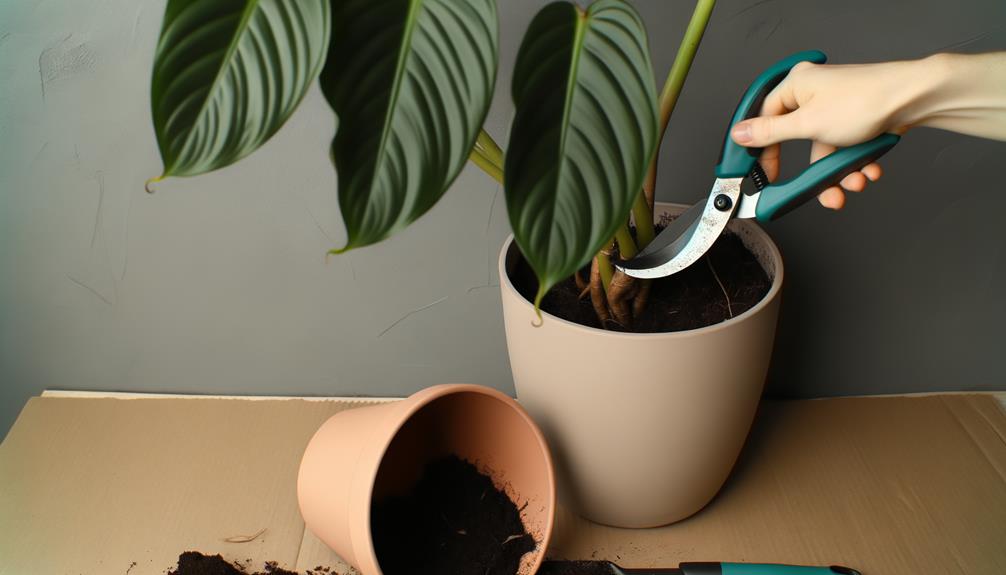
Cultivating ideal growth and maintaining the lush appearance of the Big Leaf Philodendron involves strategic pruning and timely repotting, essential practices for the plant’s overall health and longevity.
Pruning should be performed during the growing season to remove dead or yellow leaves and promote bushier growth. Use sterilized pruning shears to prevent the spread of diseases.
Repotting, on the other hand, should occur every 2-3 years or when the plant outgrows its pot. Choose a pot that’s 2 inches larger in diameter than the current one, ensuring proper drainage. Use well-draining, nutrient-rich soil, and water thoroughly after repotting.
These steps, performed with care and precision, will foster a thriving environment for your Big Leaf Philodendron.
Propagation of Philodendron Leaves
The art of propagation breathes life into new Big Leaf Philodendron plants from existing leaves, an intricate and rewarding process that is both fascinating and essential for expanding your indoor garden.
This process involves carefully selecting healthy mature leaves, preferably those with an aerial root. These leaves are then cleanly severed from the parent plant, ensuring minimal damage.
The cut leaf is subsequently placed in a container with moist potting medium, providing an environment conducive to root development. Humidity and temperature must be regulated closely, as they substantially influence root growth.
With proper care and patience, new roots will gradually form, eventually turning the propagated leaf into a self-sufficient plant.
This propagation technique offers a sustainable way to expand your collection without purchasing new plants.
Conclusion
To sum up, the care of Big Leaf Philodendron involves understanding the plant’s requirements regarding light, water, humidity, and soil conditions.
Adequate pest control, pruning, and repotting methods are crucial for best growth.
Successful propagation can guarantee the longevity of this splendid species.
By adhering to these recommendations, anyone can nurture healthy, flourishing Philodendrons, enabling these majestic foliage plants to enrich our surroundings with their unique beauty.

